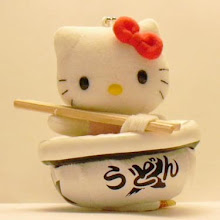Damn Camels: Onjuku & Tottori
 The artwork for the following regional items fit into the category of "vague & haiku-like." It isn't enough that she's dressed in a green tutu or as a shallot. She has to be next to a camel and on the desert. We've seen Gotochi (Japanese Regional) Kitty dressed as a number of food items, fruits and vegetables, historical and fictional characters as well as dressed in traditional garments of a certain period or region. Not much surprises me but I have to admit to being puzzled and frazzled over these items.
The artwork for the following regional items fit into the category of "vague & haiku-like." It isn't enough that she's dressed in a green tutu or as a shallot. She has to be next to a camel and on the desert. We've seen Gotochi (Japanese Regional) Kitty dressed as a number of food items, fruits and vegetables, historical and fictional characters as well as dressed in traditional garments of a certain period or region. Not much surprises me but I have to admit to being puzzled and frazzled over these items.
What is the deal with all the camels and the desert night scenes? Kitty dressed as some kind of Arabian princess? She is clearly part of the Gotochi collection, but her artwork looks like a page from 1001 Arabian Nights. Is Scheherazade a new character at Puroland? Are there native breeds of Japanese camels? From what I could tell from my internet sources the answers were no and no. So what's going on with all this night desert scenery? I finally scanned and emailed my mom a picture of the tag below. I followed up with a call and asked her what she thought this was all about. She couldn't figure out the camels- not in her memory banks, but the desert scene and the green tutu'd Kitty hit a chord. "Oh," she finally said. "She's supposed to be Nijisseiki Nashi!" Thanks, Mom. It made purrfect sense to her. It gave me a place to start my internet search.

So what did I find? While there aren't deserts in Japan, there are places that inspire the romantic images of moonlit deserts and Arabian Princes and Princesses on camelback. One such place is Onjuku Beach, Chiba Prefecture. It is said that the rolling sandy hills of Onjuku and its beach were the inspiration behind the 1923 song "Tsuki no Sabaku" or "Desert Moon" (Poetry by Masawo Kato, music by Suguru Sasaki.)
 Long ago and far away in a forgotten land
Long ago and far away in a forgotten land
In the desert late at night camels walked o’er the sand
Lost in time, a mystic line, on a journey unknown
Wearing gold and silver saddles, ‘neath the moon that shone
On the saddlebag of gold, hung a bright silver urn
On the silver saddle fold, hung an urn made of gold
So divine, another time, on a journey unknown
Tied together by a twine, ‘neath the moon that shone
On the camel’s back that night
Rode fair handsome prince
On the camel there behind, a young princess did ride
Lost in time, a dream so fine, on a journey unknown
Wearing white and wondrous gowns,
‘neath the moon that shone
Long ago and far away in a forgotten land
In the desert late at night camels walked
O’er the sand
Who could know where they did go?
Step by step, all alone
Desert dreams, misty light beams,
‘neath the moon that shone
O’er the mountains made of sand,
Hearts of gold, lips of stone,
In a long forgotten land, on a journey unknown
First camel mystery solved as well as the Arabian Princess Kitty. On Onjuku beach, there is a statue of an Arabian Prince and Princess upon camelback on a concrete dune commemorating this song. But what about the tag I emailed my mother? Is there another statue of a camel floating out there in Japan? Not quite. The answer lies on the other side of the peninsula and at another "desert-like" place called the Tottori-sakyu Sand Dune.
Tottori-sakyu Sand Dune is located near Tottori City, Tottori Prefecture. The dune is said to be the result rough winds and sea currents that return to shore the river sediments that run into the Sea of Japan. Spanning almost 10 miles along the coastline and the width of a mile, the Tottori-sakyu Sand Dune is the largest in Japan. The winds are constantly changing the shape of the dune, creating deep craters and high hills. Needless to say, the dune is quite the tourist attraction along with the reasons Kitty is dressed the the following costumes and shadowed by a camel. In addition to seeing the dune, for 1800 yen, you can take a ride on a real live camel. An imported live camel, but it's real, not a statue.






































